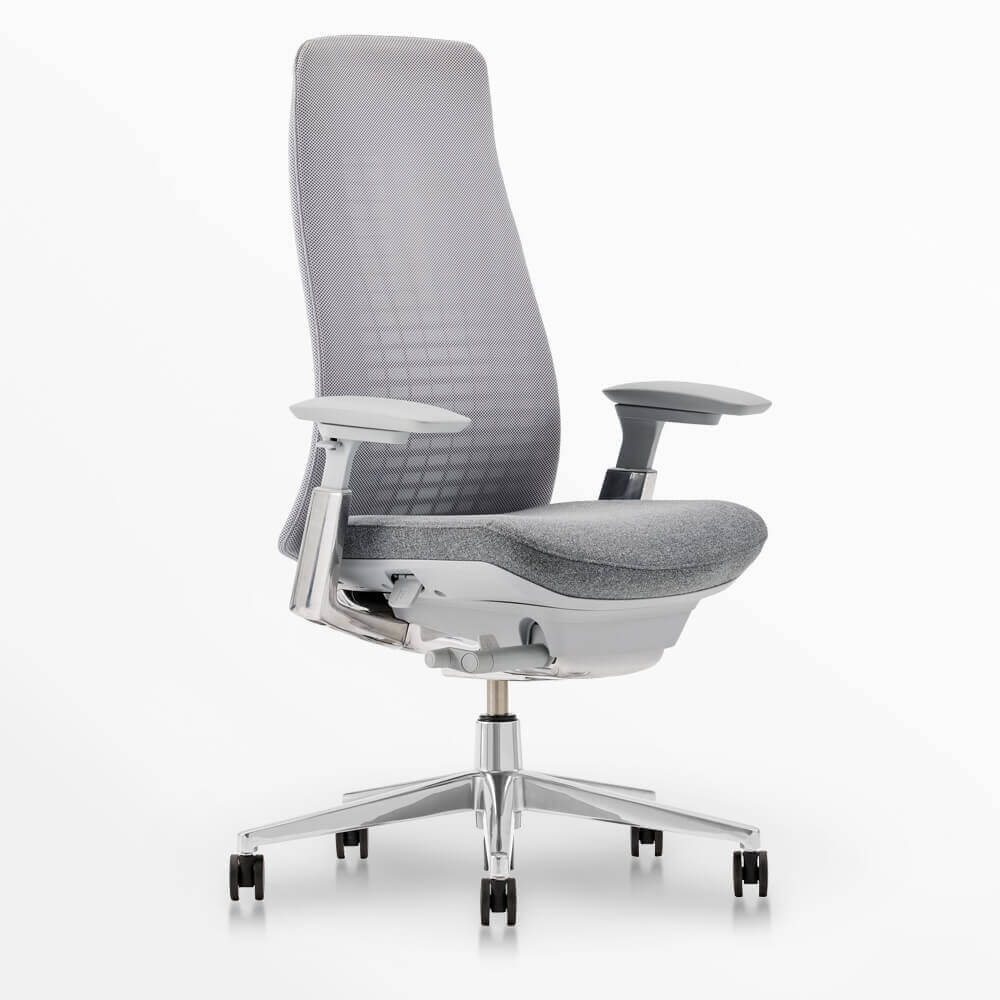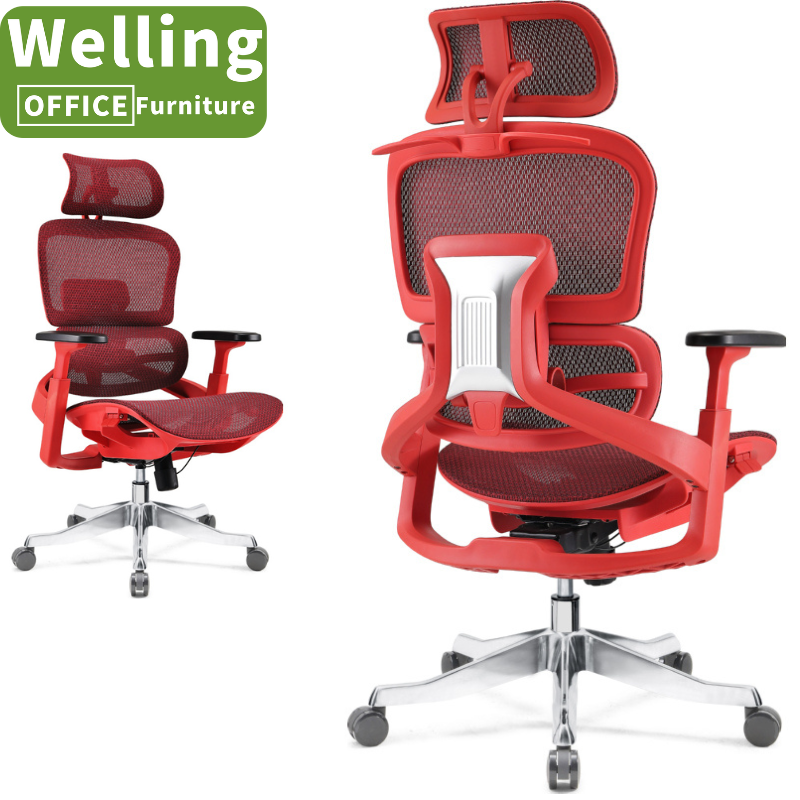Why an Ergonomic Office Chair is great for extended computer use
Wiki Article
Find Out the Crucial Functions of an Ergonomic Office Chair That You Should Take into consideration
Picking the best ergonomic office chair is crucial for any person costs long hours at a workdesk. Secret features such as flexible seat height, back support, and armrest adjustability can significantly influence comfort and position. Recognizing the value of seat depth and material high quality likewise plays an essential duty in overall complete satisfaction. Lots of forget other crucial aspects. What additional factors should be considered to ensure peak efficiency and health in the office?Adjustable Seat Elevation
When choosing an ergonomic workplace chair, flexible seat elevation is a vital attribute that greatly enhances convenience and use. This particular enables users to customize the chair's elevation to their specific requirements, guaranteeing that their feet rest level on the flooring while their knees stay at a 90-degree angle. Proper seat elevation adds to optimal position, reducing stress on the legs and lower back during expanded periods of sitting.
Adjustable seat elevation fits a diverse array of body types and workdesk configurations, making it a functional option for both home and office settings. The convenience of modification generally entails a basic bar system, allowing individuals to change the height with marginal effort. This attribute is particularly valuable in shared offices, where multiple individuals might use the exact same chair. Inevitably, purchasing an ergonomic workplace chair with flexible seat height is crucial for advertising overall wellness and performance in the workplace.
Lumbar Assistance
Lumbar assistance is an essential feature in ergonomic workplace chairs, as it helps maintain the natural contour of the back and minimizes the threat of neck and back pain. Adjustable back assistance allows users to personalize the degree of assistance according to their individual needs, promoting much better stance throughout the day. This adaptability not only improves comfort however additionally adds to overall productivity and well-being.Value of Lumbar Assistance
Correct back assistance is essential for maintaining a healthy and balanced position during long hours of sitting - Ergonomic Office Chair. The lumbar region of the spine is naturally curved, and without adequate support, this curve can flatten, resulting in discomfort and strain. Insufficient back assistance can cause a selection of concerns, consisting of lower pain in the back, muscle fatigue, and decreased performance. When an office chair provides correct back assistance, it aids to align the spinal column, decreasing the probability of establishing musculoskeletal disorders. This assistance encourages the user to unwind in the chair, advertising interaction of the core muscle mass and enhancing total convenience. As a result, selecting an ergonomic chair with ideal back support is important for individuals that spend expanded periods at their desksFlexible Lumbar Characteristics
Adjustable lumbar attributes are crucial in enhancing the performance of office chairs designed for long term sitting. These attributes enable customers to personalize the height, deepness, and firmness of the back support to straighten with their unique spinal curves. Proper back assistance reduces discomfort and advertises healthy and balanced position, lowering the risk of neck and back pain associated with prolonged workdesk job. When selecting an office chair, it is important to search for alternatives that offer simple changes, enabling users to discover their ideal assistance level. Furthermore, some chairs feature memory foam or breathable products, enhancing comfort throughout long hours. In general, flexible lumbar functions greatly add to a much more ergonomic office, cultivating productivity and well-being among individuals.Seat Depth and Width

Optimum Seat Measurements
Finding the right equilibrium in seat dimensions is crucial for convenience and support in an ergonomic workplace chair. An excellent seat width generally varies from 18 to 22 inches, fitting various body kinds while preserving ease of motion. Seat depth is similarly essential, with an advised depth of 16 to 18 inches, permitting individuals to rest easily without feeling restricted. Correct seat dimensions assure that the thighs are adequately sustained while leaving a tiny space in between the back of the knees and the seat edge, advertising circulation. In addition, the seat should make it possible for users to preserve an all-natural posture, minimizing the risk of stress. On the whole, selecting the best seat measurements is crucial for improving performance and well-being throughout lengthy hours of resting.Adjustability for Comfort

Effect on Posture
Correct seat depth and size considerably influence stance, as they directly influence exactly how a user aligns their body while seated. A suitable seat deepness allows the upper legs to relax totally on the chair without too much pressure at the back of the knees, advertising circulation and convenience. If the seat is unfathomable, it can bring view it about slouching, while a seat that is as well superficial may not give sufficient assistance. The width of the seat need to accommodate the individual pleasantly, allowing for all-natural arm placing without restriction. A chair that supports a neutral spinal column placement encourages much better stance, decreasing stress on the back and neck. Subsequently, selecting the best seat measurements is critical for preserving healthy and balanced stance throughout prolonged resting.Armrest Adjustability
Armrest adjustability plays a vital duty in boosting customer convenience and assistance throughout long term durations of resting. Ergonomic workplace chairs usually feature armrests that can be relocated different directions-- up and down, side to side, and even rotated. This adaptability enables users to find the excellent elevation and angle, decreasing stress on the shoulders and neck. Appropriate armrest placing can likewise ease stress on the wrists, promoting better hand positioning when keying or making use of a computer mouse. Furthermore, adjustable armrests suit various physique and personal choices, ensuring that each customer can accomplish a personalized fit. Repaired armrests might bring about pain and fatigue, especially throughout expanded usage, whereas flexible options provide the adaptability required for dynamic workplace. As an outcome, when picking an ergonomic office chair, considering armrest adjustability is vital for total comfort and performance at the office.Backrest Recline and Turn
Backrest recline and tilt attributes considerably add to an ergonomic workplace chair's overall assistance and comfort. These systems allow customers to adjust the angle of the back-rest, providing ideal spine look at this site alignment and minimizing pressure on the lower back. A chair with a correct recline function makes it possible for individuals to move their posture throughout the day, promoting far better circulation and minimizing fatigue.The tilt function urges dynamic movement, enabling customers to involve their core muscles while seated. This versatility is crucial for maintaining focus and efficiency throughout lengthy hours of job. Chairs that provide a wide variety of recline angles deal with different choices, suiting both upright seats for jobs and an extra relaxed position for breaks.
Material and Build Quality
The option of product and develop top quality is essential in determining the longevity and convenience of an ergonomic office chair. Premium materials, such as breathable mesh or resilient fabric, enhance air flow, giving a comfy seating experience throughout lengthy hours of use. The framework must ideally be built from robust materials like steel or reinforced plastic, ensuring stability and assistance.In addition, the top quality of foam utilized in cushioning considerably affects convenience degrees; memory foam adapts to body contours, providing customized support while lowering stress points. An ergonomic chair should additionally include a well-designed structure that permits changes, making certain that customers can personalize the fit to their private needs.
Furthermore, the build top quality must include sturdy wheels and a reliable gas lift device for smooth height adjustments. Purchasing a chair with superior products and develop quality eventually adds to much better posture, efficiency, and overall well-being in the workplace.
Often Asked Inquiries


Exactly how Do I Choose the Right Chair for My Type Of Body?
To pick the ideal chair for one's type of body, one have to assess seat height, back support, seat depth, and armrest positioning. Checking numerous versions warranties convenience and correct placement, inevitably advertising far better pose and wellness.Are Ergonomic Chairs Appropriate for Tall or short Individuals?
Ergonomic chairs can be suitable why not look here for both high and short individuals, provided they offer flexible attributes such as seat elevation, backrest, and armrests. This adaptability guarantees convenience and assistance for different physique and sizes.Can I Use an Ergonomic Chair With a Standing Workdesk?
Yes, an ergonomic chair can be made use of with a standing workdesk. It offers flexibility for alternating in between standing and sitting, promoting far better pose and comfort throughout the workday, inevitably boosting efficiency and decreasing fatigue.Just how Often Should I Readjust My Chair Settings?
Adjusting chair setups ought to occur regularly, preferably every few hours or when experiencing pain. Constant adjustments promote much better posture and convenience, enhancing productivity and lowering pressure during prolonged durations of resting. Consistency is key for excellent ergonomics.What Is the Typical Lifespan of an Ergonomic Office Chair?
The ordinary life expectancy of an ergonomic workplace chair usually varies from seven to 10 years, depending on usage, products, and maintenance. Routine treatment can extend its durability, ensuring suitable assistance and comfort throughout its life.When picking an ergonomic workplace chair, adjustable seat height is a vital feature that considerably boosts comfort and functionality. Seat deepness and size are essential aspects in establishing the overall comfort of an ergonomic office chair. Discovering the appropriate equilibrium in seat dimensions is vital for convenience and assistance in an ergonomic workplace chair. While convenience is paramount in an ergonomic office chair, the capability to change seat deepness and size plays a crucial role in accommodating individual preferences and body types. To choose the best chair for one's body type, one have to analyze seat elevation, back assistance, seat deepness, and armrest positioning.
Report this wiki page